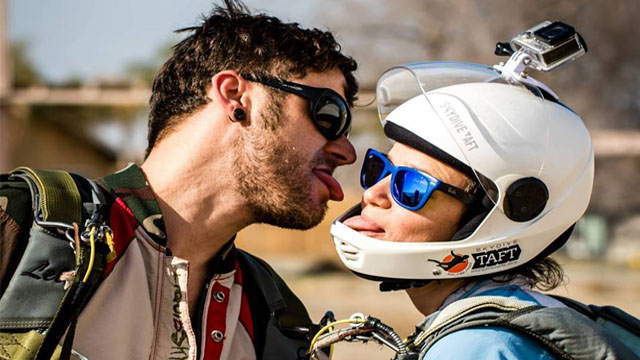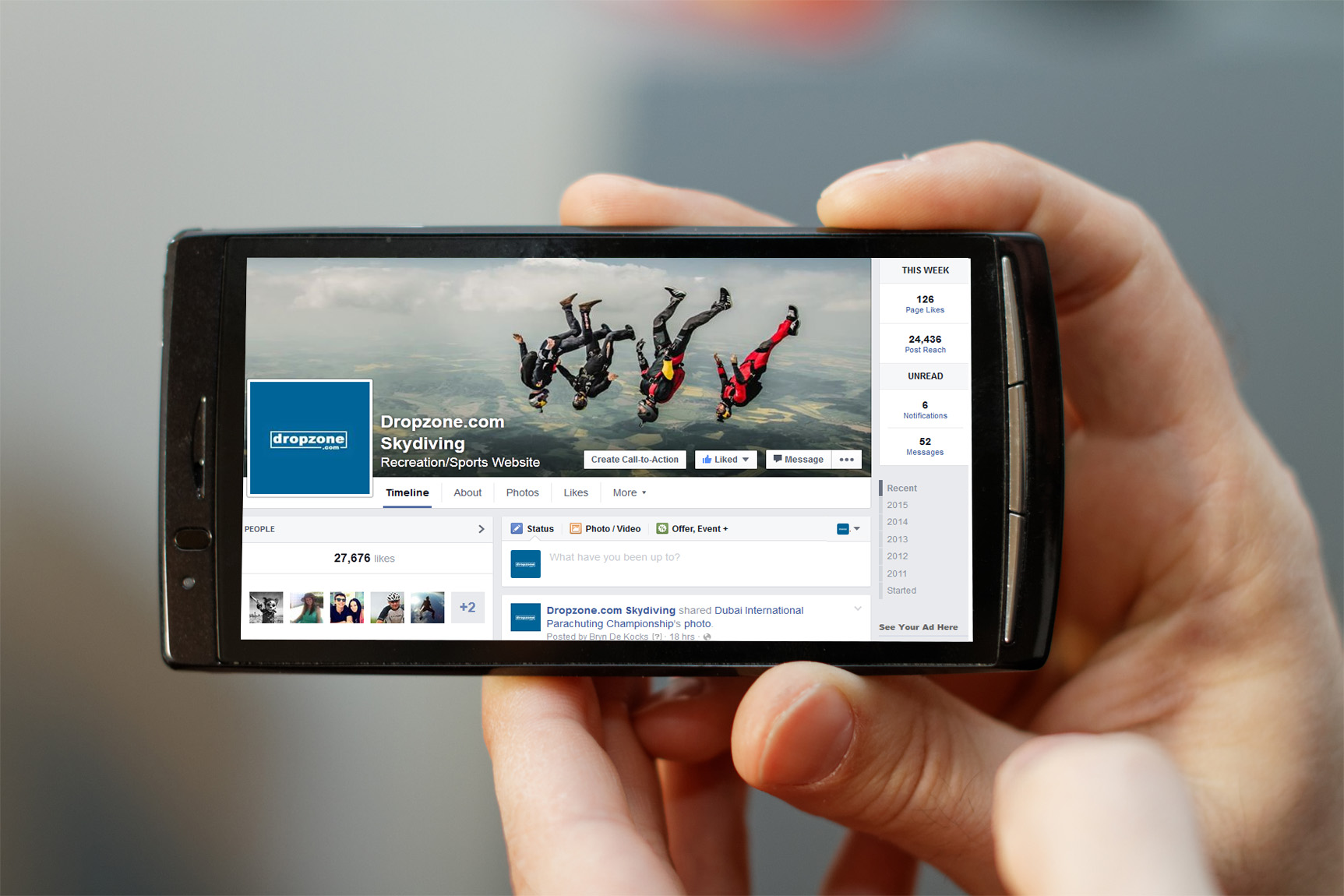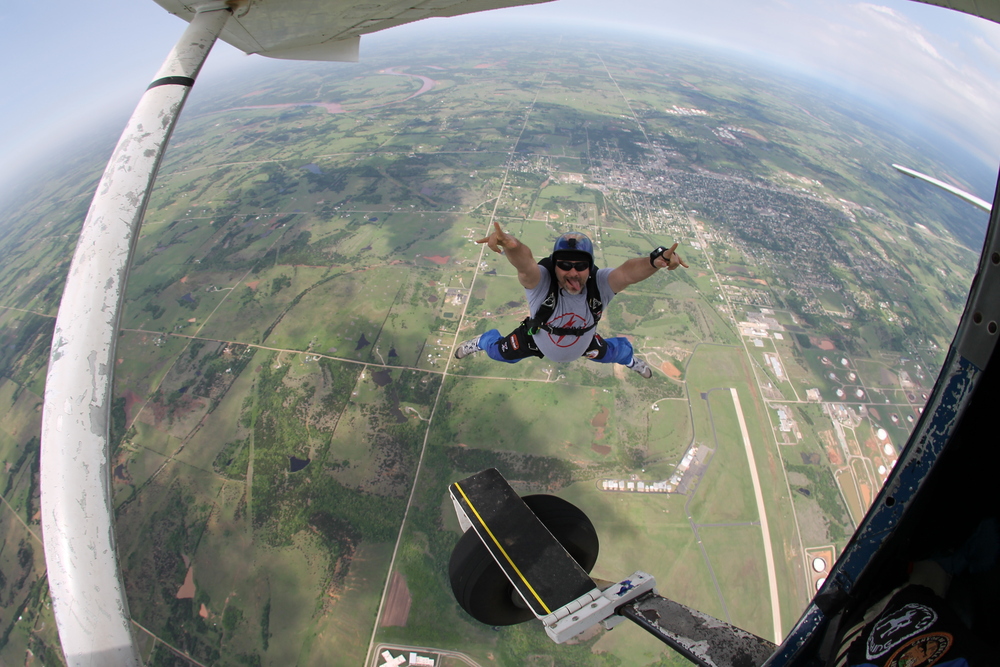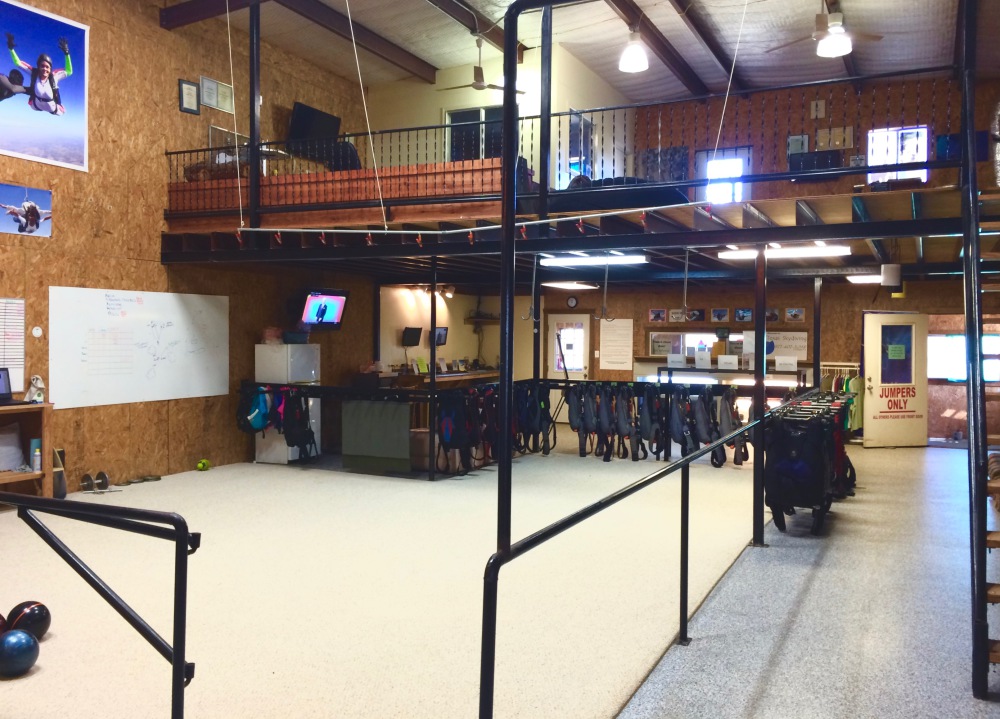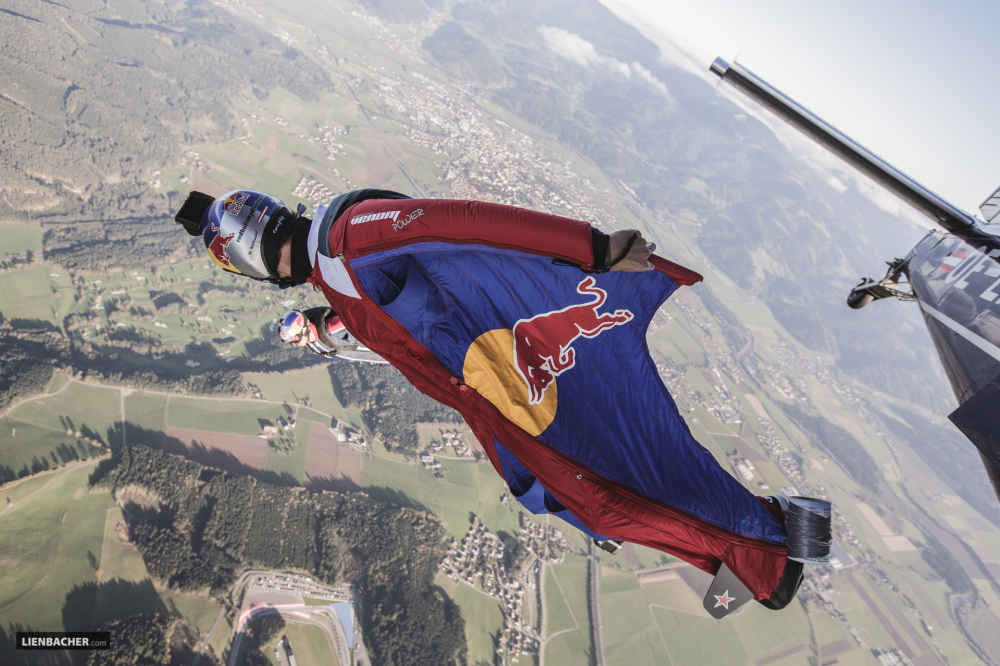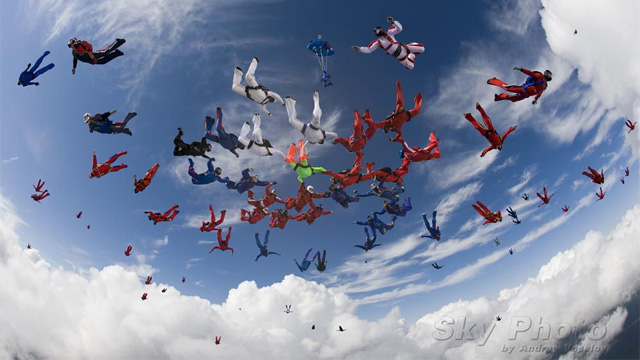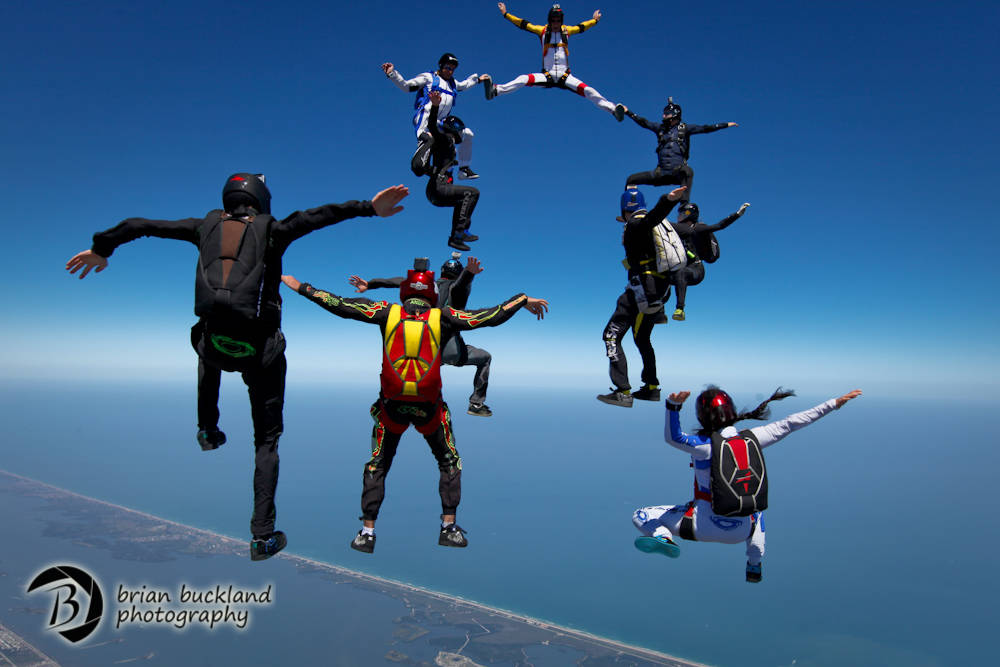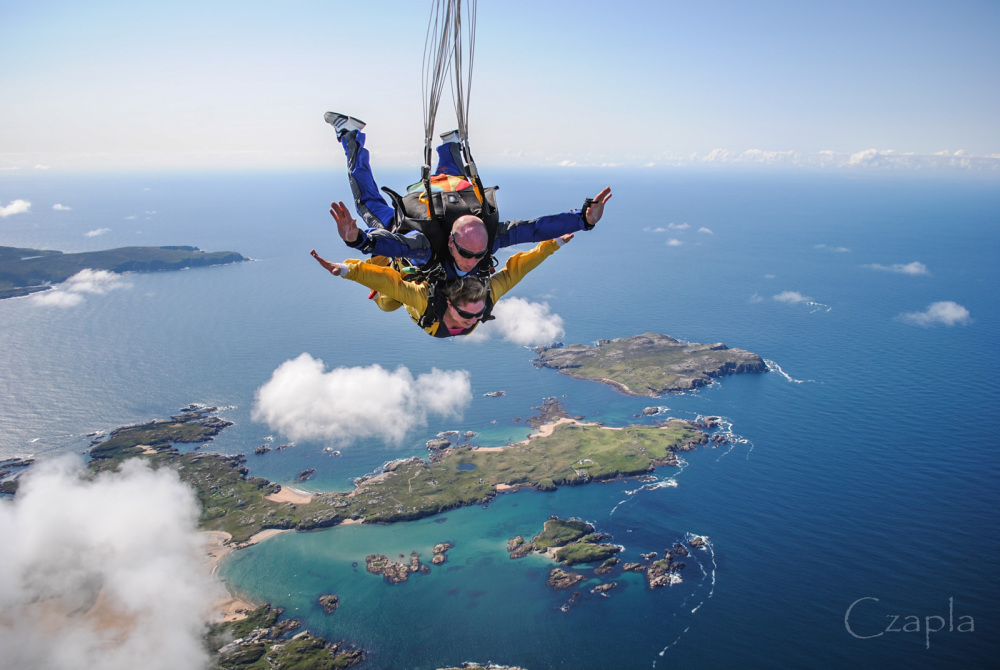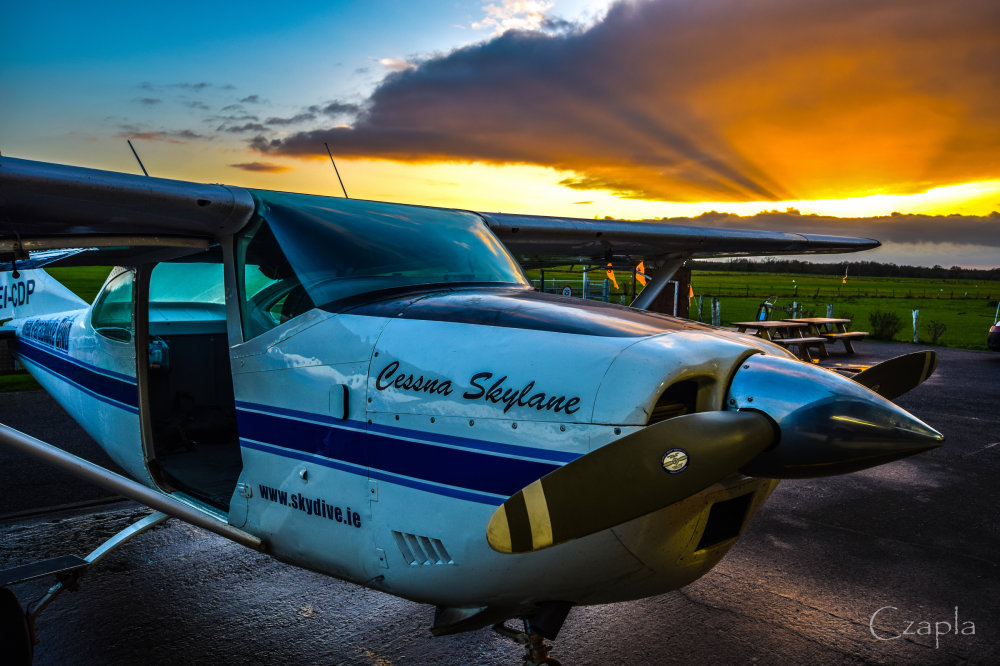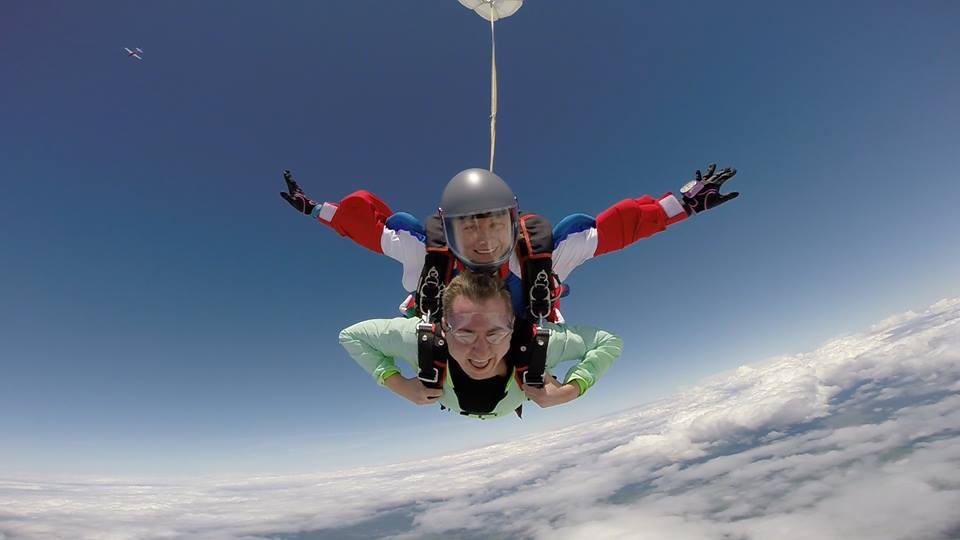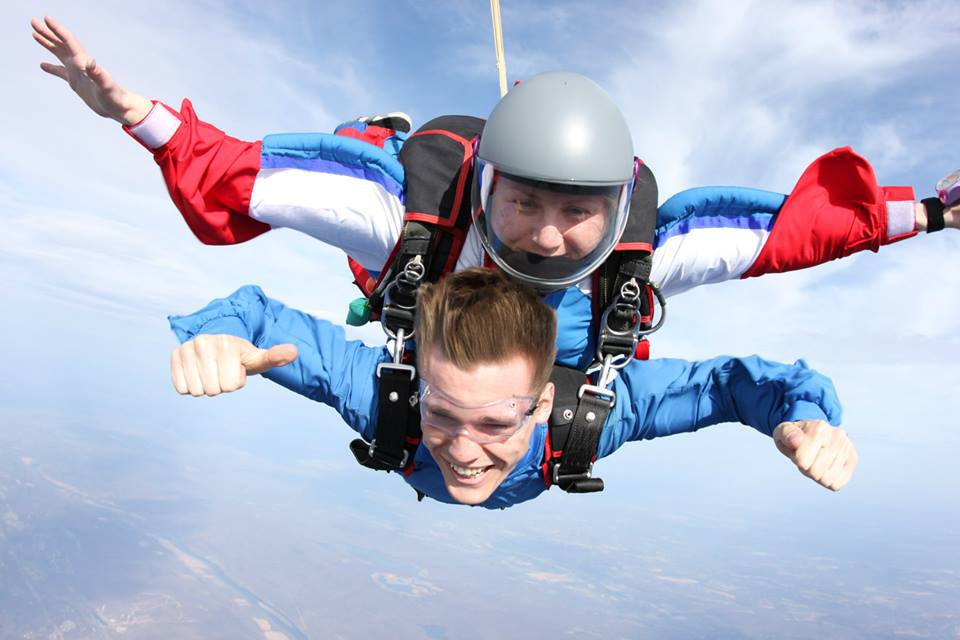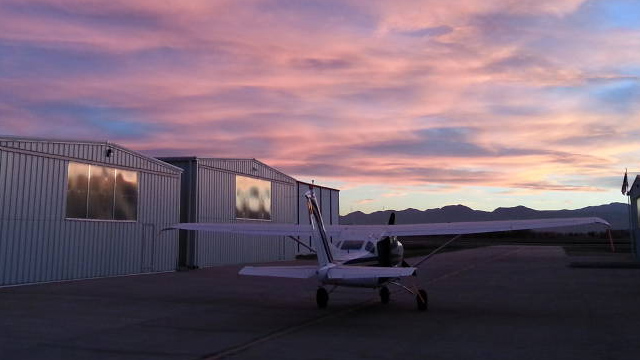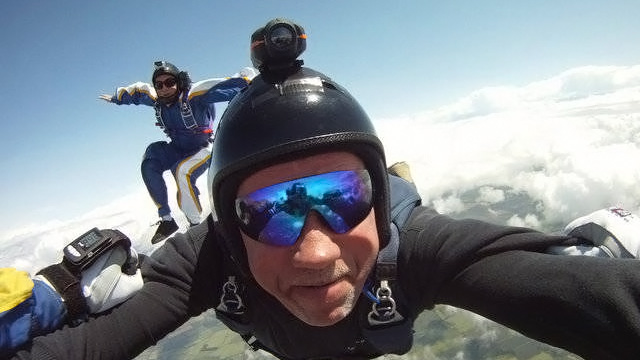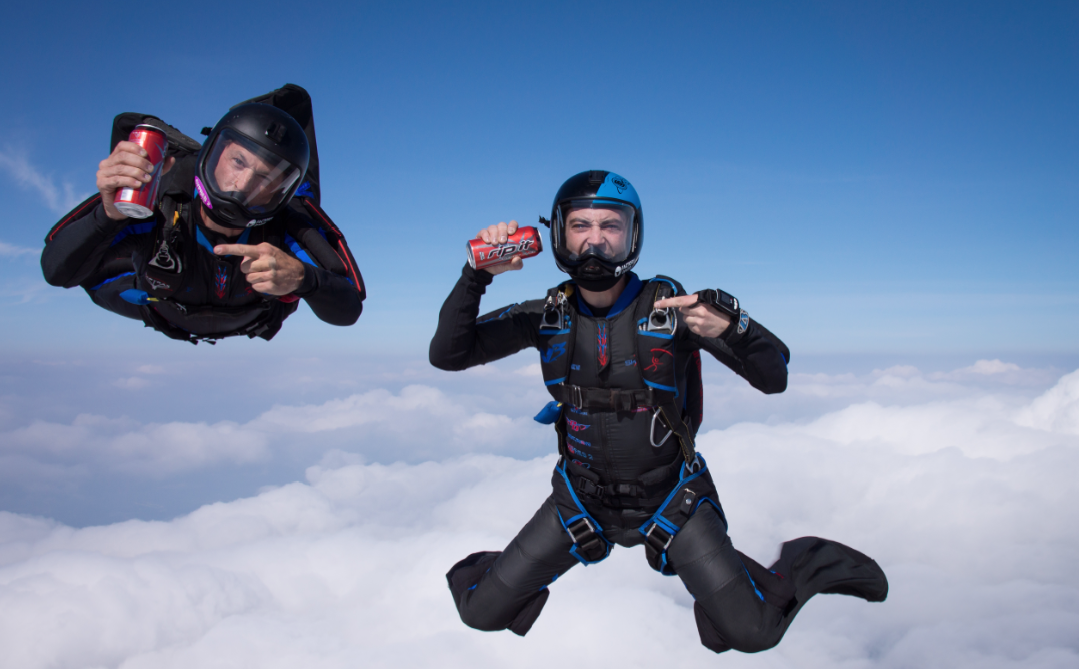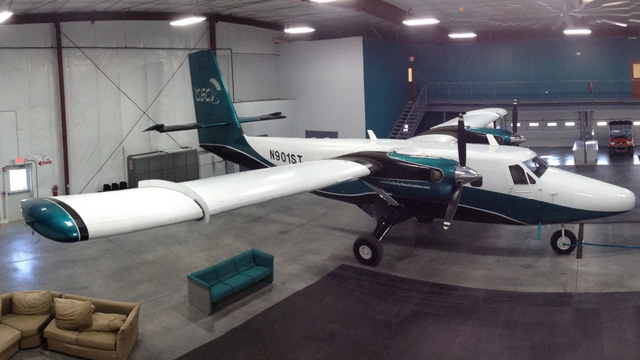Search the Community
Showing results for tags 'industry'.
Found 16 results
-
Meet the Forces of Nature That Turn Your Loads Originally published 2014. Postscript follows. Dan McNulty - Skydive the WasatchWhen I call, it’s 7:00 p.m. for me. It’s 6:30 a.m. in Afghanistan, where Dan McNulty is talking to me (presumably, with a big mug of coffee in-hand). Dan’s about to become the proud owner of a brand-new drop zone in Nephi, Utah – a quiet little one-horse town about an hour south of Salt Lake City along highway 15. The airfield is sized just-right for the easy-going, mom-and-pop affair Dan envisons: four tidy hangers, a well-maintained runway and acres of green grass for soft landings. Mt. Nebo, the highest point in the entire Wasatch and the snow capped centerpiece of the southern range, rises to a majestic 11,928 feet just alongside. Dan closes on his hangar next week. He’s stoked. He’s never actually seen the airfield, but that doesn’t bother him a bit. He’s already named it, even: Skydive the Wasatch, naturally. The season starts the second week in April. He gets home from Afghanistan March 26th. In just weeks, then, he’ll be adding a three-letter acronym to his name that only a few hundred other humans can claim: “DZO” – Drop zone Owner. Skydive the Wasatch didn’t happen overnight. Dan’s been working on this for almost two years – almost entirely remotely, patching it all together with emails and phone calls. Seeing little growth on the horizon of his current job as a security contractor in Afghanistan and being very familiar with the skydiving industry, he decided that opening a drop zone was, in his words, a “natural progression.” After an abortive attempt to set up shop on an airfield in the Heber Valley, which ended up effectively denying skydiving access with a combination of prohibitive policies and price-outs, Dan discovered the pretty little airfield in the placidly agrarian town of Nephi. “It turns out that Nephi is perfect,” Dan says. “It has everything we need. It’s close to Salt Lake City and Provo. And the city is really excited for skydiving to come to town, which is really rare and really important.” When the papers were signed, Skydive the Wasatch was effectively born (though it won’t be open for business until springtime). Dan McNaultyTo run a skydiving operation, you need a plane. Working from Afghanistan, Dan sourced an aircraft from Skydive New Mexico, a DZ with – uniquely – the same altitude as Nephi, 5,000 feet ASL. He knows, then, that this particular souped-up Cessna 182 can do the same trick for him as it did for them: climb 11,500 feet in a crisp 20 minutes. The pilot is a Moab expat with a few hundred hours flying skydivers at Skydive Canyon lands, another high-altitude drop zone. “We’re starting streamlined,” Dan says. “The basics. We’ll build as we grow. And we do intend to grow.” John Hamilton - Skydive ElsinoreJohn Hamilton, the owner and General Manager of Skydive Elsinore, knows all about growth. Though Skydive Elsinore has been an operating drop zone since 1959, the landscape of the sport has changed almost unrecognizable since he bought Skydive Elsinore with business partner Karl Gulledge. Since then, “Elsi” has burgeoned from its previous status as a small-but-historic airfield to one of the largest, highest-grossing drop zones in the world. To date, Skydive Elsinore hasn’t just hucked hundreds of thousands of skydivers over the rolling landscape aside the soaring Ortega mountain range. It has been a key partner to the advancement of parachuting technology and aerospace at large, hosting scientific studies for JPL, Pioneer Aerospace, Airborne Systems, Vertigo Inc., JSAF, Cirrus Aircraft Recovery Systems and a great many of the world’s elite air force parachuting groups. “When I first became a DZO, big surprises were a daily occurrence,” John remembers. “I guess in the beginning I can look back and say that ignorance was a form of bliss.” He laughs. “I don’t know if I ever would have taken on the challenges that awaited me if I really knew what I was getting into.” Part of John’s blissful ignorance was that he was about to become an unwilling expert in the formation of companies, legal issues, governmental regulations, employment challenges, marketing, accounting, customer service, budgeting, banking regulations, web development, social marketing, online community-building, search engine optimization and a long list of other non-skydiving-related subjects. He also had a crash course in effective communication, which he hails as the most valuable weapon in his DZO arsenal. “At the beginning, I felt like I was eating an elephant, one small nibble at a time,” he says, his smile wry. John’s relationship with skydiving has evolved from a “pure passion for the sport” to a round-the-clock focus on the business. He admits to sometimes losing sight of that original passion – he was a BASE jumper and a competitive 4-way skydiver, after all – in the thick tangle of ownership responsibilities. As he relates them, he peeks out toward the sky, a grin suddenly playing at the corners of his mouth. “You have to keep the balance. When I get lost in all this, the plane is right outside my office. I can always make a sunset load. It does the trick.” John HamiltonWhile skydiving remained relatively predictable in its equipment and disciplines for many years at the beginning of John’s tenure, the pace has picked up significantly. “In today’s skydiving industry, challenges arrive almost overnight,” he asserts, “And they change just as fast.” Modern DZOs must constantly adapt to the logistical, safety and economic challenges posed by the sport’s ever-changing pantheon of disciplines. “With the advent of horizontal flight – wingsuiting, tracking, angle flying, etcetera – we have had the challenge of integrating a whole list of new safety policies, while at the same time working with the governmental agencies who govern our sport.” “The feedback from our jumpers varies widely,” he continues, “and much of it makes me think that the vast proportion of jumpers don’t understand the hard work we must do in order for them to enjoy these new methods and technologies. It’s about so much more than the sum of its parts, and jumper cooperation is key, but I am ultimately responsible for the safety conducted on the drop zone.” John refuses to create an atmosphere that influences younger jumpers to push their own abilities too far. He’s known for his tireless encouragement of Elsinore’s instructional staff – and experienced jumpers, too – to lead by example, even as the community undergoes exponential growth. “I understand the thrill for newer skydivers to want to push the limits of disciplines in the sport. Trust me, I do. But it’s important for those jumpers to understand that keeping a safe culture lets us all continue to skydive.” Elsinore’s track record, for the number of jumps made here, is stellar. However, it’s a numbers game – and it doesn’t always work. “The biggest headaches of my job are, almost without exception, those that stem around the many legal risks and challenges associated with running a skydiving center – the intersection of personal responsibility and DZ responsibility, for the most part.” John pauses. “For example: a student will turn themselves into the ground, then will doggedly challenge the waiver and try to find blame in everyone else, without taking any responsibility for their own actions.” “It’s challenging, yeah. It can be a Herculean undertaking.” He pauses. “However – I get to see people’s faces after they land from that first tandem skydive. I get to know that I was part of that life-changing event for every one of them. It brings a huge smile to my face, every time. I get to help the next generation of skydivers grow as athletes and as people. It is absolutely worth it.” In passing, I tell John about Dan McNulty and his new drop zone in Nephi. John leans in. “Here’s what I’ve learned from my experience: Find a good lawyer. Then find a good accountant,” he says. “Also: It may seem unnecessary – counterproductive, even – but do things by the book in all cases. You may think you’re saving money, or even making money, by doing one or two things in the proverbial grey area. You’re not. Trust me.” He continues. “Learn to accept the rule of thirds: one-third of the people you deal with will like you, another third will tolerate you – and the last third won’t like you one bit. That doesn’t matter.” He takes a level breath. “When you’re dealing with a difficult situation, forget about public opinion and ask yourself the following before you communicate a response: am I doing this because it’s the right thing to do, or because I want to prove myself right? The answer is almost always obvious.” Lelo Mraz & Claudia Blank - Skydive TaftIt’s unsurprising that John inspired others to follow a similar path: specifically, two good-looking Brazilian kids with megawatt smiles. Lelo Mraz and Claudia Blank have been beloved members of the Southern California skydiving world for a couple of decades. Recently, they joined business partner Michael Choi to become the proud new owners of their own facility: Skydive Taft. Lelo and Claudia arrived in Redondo Beach in the early 2000s from different small towns in their shared native country, and promptly fell in love. Lelo had started jumping seriously in Brazil back in 1995; he’d logged hundreds of hours in the Perris sky and tunnel by the time the two showed up to Elsinore as a pair. Claudia, on the other hand, hadn’t made so much as a tandem. Suddenly, in 2008, she decided offhand to do a jump. Naturally, Lelo ran outside video. By 2009, Claudia was an inveterate skydiver and, like Lelo, had a full-time job at the Skydive Elsinore DZ. The pair loved their jobs. They loved the Elsi community. They loved the skydiving. But they’re also clever, enthusiastic folks who love a challenge, and Lelo knew they couldn’t stay there forever. “I came up with the drop zone idea a couple of years ago,” Lelo remembers. “I’ve always known that I wanted my own business, and I know skydiving really well, so I was kicking around business plans, trying to come up with numbers that would be workable.” “I first looked into wind tunnels, but the investment is around ten million dollars. When I started to investigate drop zones, the money part started to make sense.” He started talking to mentors: not just John Hammond, Karl and Laurent “Lob” Lobjoit from Elsinore, but Rich Greene from Oceanside, as well as other pros who had walked the mine-strewn path before him. Lelo Mraz & Claudia BlankIt took time, of course. “I spent a lot of time looking into airfields around California – we love California, and definitely didn’t want to leave. Nothing seemed to work, though. Then one day I was joking with my partner, Michael Choi, that maybe we should go check out Taft – even though it’s in the middle of nowhere – and that day, I saw an ad that it was for sale. It seemed like it was meant to be.” From there, things moved quickly. There were signatures on the paperwork by last October, and the new crew took over the DZ on November first. The Taft airfield is surprisingly big for its slightly out-of-the-way location. It has several hangars, a paved runway, two parking lots, a huge landing area and plenty of room for an active community of jumpers to settle in. So far, the pair is strategically running a small plane and slowly, thoughtfully rolling out a master plan for the DZ to be a regional center for training, rigging, courses and ratings. It’s no easy task for young entrepreneurs – especially, for longtime members of the skydiving community – to take over a dropzone that’s been operating for as many years as Skydive Taft. Over the facility’s 24-year history, it had accrued a small-but-very-loyal following of fun jumpers who hadn’t seen much in the way of change before Lelo and Claudia appeared smilingly in the office. Ever. “Most people like us, and we try hard to be fair, but we had to implement some policies that we felt to be extremely important from a safety standpoint,” Claudia explains. “A lot of the people who have been at Taft for so many years feel like it's their drop zone – like they own it. We don’t want to lose them, but some people get angry if we even move a couch.” She continues, “We decided to make changes little by little, taking a more careful approach than we thought we’d have to take.” Claudia gives a wry smile. “So far, so good. But it isn’t easy.” Leaving the tight community at Elsinore, too, was a struggle – and remains so, as the move is still fresh. “I can honestly say that I had no complaints at all about our ‘old life’ in Elsinore,” Claudia muses. “It was so hard to completely walk away from what was already a dream job. I made money on the weekends and jumped for fun on the weekdays at one of the most beautiful DZs in the world. I loved it, and I loved my coworkers.” “I was in denial until we finally had the paperwork,” she continues, “I knew that as soon as I made it official and quit, there was no turning back, even though they made sure to tell us that the door would always be open. This process – it changes something inside of you.” The Elsinore team threw Lelo and Claudia a huge, very-well-attended farewell party, popping up with little surprises all day long, paying for as many jumps as the couple wanted to do and dedicating one of the drop zone’s signature paving tiles to them as a memento of their long service. There were tears. It’s hard to spend time in nostalgia, however, when you have so much on your plate. For example, the first big boogie for the new drop zone is just around the corner: the Cal City Reunion, on March 22nd. Taft is sporting a bigger plane for the event and getting ready to welcome its biggest-ever crowds. “For now, we're really new. We have a lot to learn. We have been going with the flow, but being very strategic with funding. We're not going into debt; we're working with savings. It was a leap of faith, but now – even though it’s winter – business is picking up, and money is coming in, so we feel OK.” Meanwhile, in Afghanistan, Dan McNulty is working on the final details of the Skydive the Wasatch process. The tandem rigs are already bought and inspected, Today’s checklist includes arranging for delivery of the plane and closing on the hangar. “This has been a very creative process, so far,” Dan notes. “When I set out to do this, I was sure about one thing – that I'd never work for anyone else, ever again. It means that I am 100 percent responsible, for better or for worse. But it means that everything I do means something. John Hammond seconds the sentiment. “Just when I think I’ve seen it all,” he laughs, “I am quickly reminded that I haven’t. Each and every day I run this dropzone brings new people, new challenges and new surprises.” There is, clearly, an art to DZOing. ----------- Postscript: In the seasons since this article’s first publication, both Skydive the Wasatch and Taft have, predictably, thrived. Claudia and Lelo are hosting the full-on Liquid Sky Free fall Fest in August. Dan McNulty has even picked up another drop zone: Piedmont Skydiving, in North Carolina. Go jump with these guys and give ‘em a high-five!
-
Have you ever been at a restaurant and observed a group of people not speaking to one another because everyone was staring at their phones? The age group most likely to be "engaging" this way are people born between the years 1980 and 1996 - the Millennial generation. There’s a lot of good news about Millennials for the skydiving industry (for example, they put experiential value ahead of ‘stuff’), but there's some bad news too: many of us haven't adjusted our marketing plan to capture the Millennial market. We've only just begun to dip our toes into the vast ocean of digital marketing which would enable us to meet Millennials where they are - online. Having a functional website and a Facebook page is no longer enough; to effectively reach this demographic, we need to be fully immersed in the channels they are using and understand why they use them. Why You Need To Be Marketing To MillennialsAlthough skydiving caters to individuals between 16 (depending on your country) and 106, the number one target demographic for the skydiving industry is men and women between the ages of 25 and 34. Have a look at your Facebook Insights and you'll probably notice that the largest percentage of your fan base usually falls within this category. And this category fits squarely within the age range of the Millennial generation. Love or hate their addiction to smartphones and tablets, there’s no denying that 18-34 year olds are an important segment, if not the MOST important segment of your customer base, and their influence is growing. According to a recent U.S. Census Bureau, Millennials will surpass Baby Boomers as the largest living generation in 2015. In the U.S., Millennials are responsible for an estimated 1.3 trillion dollars in annual spending. This number will only increase as more Millennials reach their peak income earning years over the next two decades. The future success of your business will depend in large part on your ability to properly market your services to the Millennial generation. As digital natives, the way Millennials interact, view, and engage with the world around them is completely different from previous generations. Their preferences are different, their values are different, and their spending habits are very different. Companies who want to effectively tap into this growing demographic are going to have to embrace a completely new marketing strategy that takes these differences into account. In a recent report, “How Millennials Are Changing the Face of Marketing Forever,” The Boston Consulting Group outlines the ideal marketing strategy for capturing the Millennial generation. They call it reciprocal marketing and describe it as follows: “Instead of being a process that is led and pushed by companies, modern marketing is an ecosystem that is influenced by some factors that a company can control and some that are beyond its control. It is a system in which marketers, customers, and potential customers perpetually exchange experiences, reactions, emotions, and buzz.” How To Create An Effective Reciprocal Marketing Campaign1. Be WHERE Your Customers Are To effectively reach Millennials, companies must be present online and offline; they must have a strong mobile presence. According to the Pew Research Center, roughly 83% of Millennials now own a smartphone. Of those, 50% report that their preferred device for accessing the internet is their smartphone. This means many of your potential customers are accessing your website on a mobile device. Have you visited your website on a smartphone or tablet lately? How does it look? Is it easy to read and navigate, or do you have to constantly pinch and expand to see the text? Millennials are the instant gratification generation - If your website is not responsive (meaning it automatically adjusts to fit any size screen or device), chances are they won't be sticking around for long, and you won't be getting their business. 2. EMBODY What Your Customers Aspire to Be Millennials are looking to connect with brands that reflect their values and project who they aspire to be. What do Millennials value? Luxury, adventure, excitement, travel, and authenticity – to name a few. They describe their generation as tech savvy, modern, risk taking, rebellious, smart and humorous. If you want to strike a chord with Millennials, make sure that your company’s messaging, imagery and personality reflect what they value. This shouldn't be too difficult - what could be more adventurous, exciting, authentic, and rebellious than skydiving? And there's more great news for our industry: a recent poll found that Millennials place a higher value on life experiences than on physical possessions. In fact Millennials’ spending habits are the driving force behind the new “experience economy.” 78% of Millennials said they would rather spend money on a memorable experience than on an object; 72% indicated that they would likely spend more money on experiences than physical things next year; and 72% reported suffering from FOMO (fear of missing out), a condition that is driving them to engage in more experiences so they can “keep up” (i.e. post pictures and status updates of their exciting life experiences) with their social networks. 3. ENGAGE with Your Customers to Build Trust If you want to build customer loyalty among Millennials, you must engage with them. Millennials desire to interact and share their experiences and opinions with companies through social media. Research indicates that recognition is extremely important to Millennials so when you open up a dialogue make sure you are prompt to reply to customers who engage with you. Make them feel as if they have a personal relationship with your brand. Millennials are overwhelmingly skeptical. Only 19% believe people can be trusted. This means a company has to work hard to gain and maintain their trust. Authentic engagement via social media is one of the best ways to do this. When you build loyalty with Millennials who have already used your services, you encourage them to share their opinion of your company with their friends. And because Millennials’ purchasing decisions are largely influenced by friends and family, making your current customers brand advocates will reassure their social circle that you are a trustworthy company to do business with. Social Media - Quick Facts52% of Millennials follow/like their favorite brands online via social media channels. Facebook is still by far the most popular social media channel with Millennials, but more users are engaging with multiple platforms daily. Relevant platforms:2014 Usage Statistics (18-29 years old) Facebook = 87% Twitter = 37% Instagram = 53%
- 2
-
- industry
- general safety
-
See more
Tagged with:
-
Image by DeltaBravoAs spring draws near it is time once again to start thinking about the summer jumping season. Most drop zones will start to organize their safety day activities, gear will be inspected, and repacks scheduled. However, what many of us forget to do is spending some time developing our coaches and instructors after all, professional skills can be forgotten during the winter months just as easily as safety rules and regulations. For many drop zones, instructional development stops after the candidate’s progression card is signed off and the certification is issued. What we fail to realize is that instructional skills are perishable and everyone can benefit from annual employee development training. What I would like to discuss here are some methods the average drop zone can use to develop their instructors. Understandably not all of these are possible at every drop zone, and individual drop zones may have to modify these methods to fit into their procedures, but these are simple and can be done with little imposition on the drop zone. Before I talk about training techniques I would like to discuss certification and training records. I am not about to suggest that drop zones start massive files on their people, but the drop zone owner is an employer and even though most of the employees are classified as independent contractors, the DZO/DZM should have a basic training folder for each instructor. Some things that might be useful to include would be copy of class 3 medical certificates for tandem instructors, copies of CPR/First Aid certification cards, awards, and even the latest logbook entry once a year (I’ll discuss the last two more later on). Although none of these items fall into the privacy act, the DZO/DZM should still keep the files locked up and they should only contain the document copies, never the originals. This will prevent the information from being passed around or discussed publicly. Now that we have the staff, and their records are in order, how are we going to mold them? To renew an instructor certification, the individual must attend an instructor’s seminar. The majority of the time that seminar is the annual safety day, but instructors need something more. I have heard many DZOs/DZMs make the comment that the requirements to become a certified instructor should be made more stringent. I even heard one person advocate that a coach should have a minimum of 500 jumps. Although that sounds great in theory, logistically it is almost impossible. Instead of just forgetting about instructors and coaches after they have become certified, get them all together once a year. Pick one of them to give the ground portion of the First Jump Course while all the other instructors are the students. This will allow for all of the instructors to provide constructive feedback to each other and it will give the instructors a chance to relearn something they may have forgotten. One thing that is frustrating for a new student is when one instructor says, “Remember? In class you were taught to….” When in fact that was something the other instructor forgot to teach in class. By holding annual employee development training not only will the instructors benefit, but so will the students. Free Fall DrillsAnother technique is to practice free fall drills. It happens to all of us. We, as humans, can get sloppy with our techniques overtime. Two instructors or coaches jumping together would be in a position to debrief each other. This can be done as a fun jump, but as long as it is not a free fly jump or a “zoo” dive. After all, we are not free flying with first jump students and they are jumping exact dive plans. I do want to stress at this point that instructors must help each other out. If it is in the plan for one person to act like a first jump student, then act like one, but let’s be honest, how many first jump students actually put their helmet on backwards and start playing with the aircraft controls as soon as they get in the plane? Although I’m sure it does happen on occasion, not to the extent that I see people acting it out when teaching new instructors. Discuss with each other what you have seen over the past year, but don’t make the training so unrealistic that it is ineffective. Have an instructor day at the wind tunnel. Since wind tunnels are beginning to spring up in more places take advantage of it. Video the time in the tunnel and spend some time doing dirt drills working on areas that need improvement. Emergency TrainingMany DZs will invite the local rescue squad out on safety day and there are others that don’t like to do this because they do not want to scare the new jumpers. I can understand both sides of this, but it doesn’t take away from the fact that this is a dangerous sport. It is a good idea for all instructors to have basic first responder training specific to the types of injuries that could be experienced at the DZ. Subjects such as C-Spine immobilization, when to move an injured person and when not to should be taught to all instructors. What about the injured person’s helmet? Should it be left on or taken off? How do you safely remove an injured person from the swoop pond? When the call is placed into 911, what information is the most helpful? Does the staff know the address to give the 911 operator (that is a good thing to type up and put by the phone, by the way). This brings us back to the training folder. One of the things that would be a good idea to keep in the folder would be copies of awards and maybe even a copy of a recent logbook entry. If there is ever an accident or fatality at the DZ, the DZO/DZM will have to deal with the media. By having key information handy, the DZO/DZM will be able to make a quick and informative statement to the press if needed. For example, if someone were to get hurt during a tandem jump, the DZO could say, “This is a very unfortunate accident and we are looking into the cause right now. The instructor is highly experienced and has over 10,000 jumps, 9,000 of them being tandem, and just two months ago was awarded the USPA badge for 50 hours of free fall.” Many people don’t like talking to the press, and that is the subject for another article, but the fact remains; by just saying no comment you leave the uneducated alone to make up their own answers based on hearsay, rumors, and their own fears. As you can see, there are various ways for a drop zone to develop their instructors. Although not every way is possible, nor has every possible way been covered, we must remember that drop zones are businesses, instructors are employees, and once in a while, employees need refresher training too. Corey Miller C-38834 Corey has a Master’s Degree in Aeronautical Science, specializing in Human Factors and Education. He has over 30 years of experience in both aerospace and military aviation. He is currently the Quality and Safety Manager for the ATM Program in Kabul Afghanistan but he calls the Oklahoma Skydiving Center his home.
-
I crack the conversation at breakfast: I want to write an article about how the sponsorship model has changed since the beginning of airsports. I remark that I imagine it's going to be a long one -- a book, maybe. My laid-back, easy-going, lassaiz-faire partner (who is, coincidentally, sponsored) almost immediately dusts off and sharpens his little-used claws. Why? Who's going to want to talk about it? What's my problem? This is a touchy subject. Sponsorship, after all, is becoming -- has become? -- a necessary evil. If you're entirely self-funded (and haven't burst forth from fountains of preexistent wealth), you're going to hit a glass ceiling somewhere. No matter what your level of talent, you're unlikely to command any spotlight time in the Airsports Circus without outside support. Sure, you can throw drogues or point cameras at shrieking tandem passengers. But there's no question that you can do a lot more when you look like a floating Nascar -- and it seems like everyone "serious" is gunning hard for those logos. There's an implicit promise in those colorful little patches: the latitude to finally bin your ragged-out gear; to go on the event circuit; to join the big leagues. It's not just skydiving, of course. The windy tube is an even-better example. If you're not the lucky recipient of sponsored minutes, you'll probably burn a full workweek throwing meat around (with a few short demos thrown in) before you get the chance to work on your own stuff. Then, of course, there's BASE jumping. A sport that used to be about jumping situation-ally inappropriate gear and hoping for the best is now highly technical, multi-disciplinary, thronging with new talent and all about the suit upgrade. Full-timing BASE pretty much requires a full lifestyle reboot (and perhaps a cross-continental move). Head-to-toe black and yellow sure doesn't hurt -- a color combination that occasionally comes with a staff packer and access to sky scraping diving boards. There is, of course, an inconvenient truth at play here: tiling yourself with logos like a mangled game of Connect Four won't put food on the table. Those insignia don't, in and of themselves, represent a living (unless you’re one of the handful of athletes gumming the teat of full-on government funding). Most of them represent gear discounts; free gadgets; a few bucks shaved off each jump ticket; a vetting of your coaching value; a recursive validation you can enjoy whenever you look at your suit, or your canopy, or your Facebook feed. Go 'head and throw 'em all on the table like you're playing Sponsorship: The Gathering, but you're still gonna need a day job. And even then -- as Clif Bar so famously demonstrated -- no sponsorship arrangement is forever. And what price support? "It forces noncompetitive people to be competitive," sighed a household-name friend of mine over drinks. "It makes totally normal, grounded people look and act like #$%&*@ glory hounds." And if you complain, of course, you're an ass: after all, you made it. Why are you whining? Aren't you smoking cigars and eating caviar among the cosseted elite? There is lots to ponder, here. How does a high-benefit sponsorship change an athlete's relationship to these sports*? How does it change athletes' relationships with each other? How does outside support change the sport itself? And that, of course, begs the question: how many fatalities could be connected to upping the stakes for a sponsor? Legendary MotoGP winner Valentino Rossi said it best, I think, when he was asked why he didn't switch out his beloved number 46 for the 1. It's the champion's right and privilege to do so, and he turned it down win after win after win. "The number one," he said through a sideways smile, "is very heavy on the front of the bike." * Interesting follow-on reading: a 2010 study by Daniel Kahneman and Angus Deaton on what scientists call the "overjustification effect."
- 2 comments
- 12
-
- industry
- general safety
-
See more
Tagged with:
-
Image by Andrey VeselovDo you wish to increase profitability and grow your DZ? If so, read each of these 10 points closely. As a DZO, you are no doubt constantly bombarded by marketing companies trying to get you to spend your precious money. These marketing efforts generally result in little to no ROI. Focus on the objectives below, do them well and you will see growth. 1. CUSTOMER EXPERIENCENo matter where your DZ shows up in a Google search, if the customer experience is not great, then no amount of marketing will matter. With platforms like Yelp, TripAdvisor and Google Reviews, the power of word of mouth has never been stronger. Delivering a great experience is not the same as executing a safe skydive. Identifying each individual customer point of interaction and making it a five star experience is the total package. Master this and watch your business grow. If you spend no money on marketing, get this right because many of your competitors are not. Tip: Survey your customers 24 hours* after their experience. The questions should revolve around each individual customer touch point. This is eye-opening as it will reveal the weak points of your business. * Do not survey immediately after the experience. Everyone is on a high and will give feedback that is skewed. 2. SEOIf you’re not on page one of a Google Search, then you’re invisible. The majority of your guests will search for your business via Google and few of them will be leaving the first results page. Educate yourself on what you need to do to ensure that you show up on page one, preferably near the top, in organic (unpaid) Google search. Be sure to find out the most commonly used search terms for skydiving in your region to identify what search words to focus on. This is hugely important to get right. Tip: Do not be fooled by SEO companies that promise to bring your page to number one. If an SEO company reaches out to you with this kind of guarantee, it should be a red flag. Tip: When seeing where you show up on a Google Search, don’t search for the exact name of your business. Search using terms like ‘skydiving’ ‘in’ (enter nearest big city). 3. WEBSITEYour number one marketing tool will be your website. Don’t do a barter trade for jumps with someone that knows web design unless they are a) great at design and b) understand how to optimize the back end of the website for search. There are many functional websites in the skydiving industry that are not strategically optimized for search engine performance on the back end. Having a great looking website means absolutely nothing if the back end of the site is not correctly optimized for search. Many web design companies will simply create a site for you and then leave you to employ an SEO company to fill in the gaps. Utilize a design company that will create both a great design and optimize it for search. 4. WOMMWord of Mouth Marketing (WOMM) is the most powerful form of marketing because we all trust recommendations from our friends and family along with review sites. IF you’ve identified all customer touch points and are receiving great scores in your customer surveys, then it’s time to implement a WOMM campaign. A WOMM campaign transforms customers into the marketing team for your business and best of all it’s free. Use lagniappe, leverage social media and implement a strategy that makes it very easy for your customers to write a review for your business. Tip: When implementing a WOMM strategy, it’s important you’re focused on the overall customer experience. If not, it’s highly possible you’ll receive negative reviews. 5. E-MAIL MARKETINGE-mail marketing is FAR FROM DEAD. However, effective email marketing requires much more than just sending an e-mail out every once in a while – there is a technique to creating a great e-mail marketing campaign. The growth of DropZone Marketing is due, in large part, to our e-mail newsletter campaign. Providing free marketing information (quality content) that is graphically pleasing and suited for mobile devices is a great marketing tool for any business as it keeps you in front of your customers and should help drive traffic to your website which helps with SEO. 6. SOCIAL MEDIAEveryone knows that social media is a powerful medium, but few in the skydiving industry are leveraging it correctly. First, don’t try to be on all social channels. Select up to three channels and do well on each of the three. My recommendation is to focus on Google+, Facebook and Instagram for the skydiving industry. Focus on engagement rather than number of followers. If you’re not increasing your engagement with your followers, than your efforts may be a waste. Be consistent, be authentic, and really make an effort to engage with your audience. Tip 1: Google+ is relevant for SEO. Google will index its own networks when executing a search, so it’s worthy being there. Tip 2: Learn Tips for Mastering Facebook to better utilize this platform. Tip 3: Understand Instagram. 7. GOOGLE ADWORDSOne of the most powerful advertising tools is Google Adwords and is something I would recommend for every DZ. Do not waste money on billboards, TV or print advertising, you will not get a return on this investment. AdWords can be implemented by anyone, but if not managed correctly can become a waste of money. Presently, I’m seeing many DZ’s ads showing in markets hundreds and even thousands of miles away from a DZ’s region. AdWords should be monitored closely and keyword research should be done in order to create the correct marketing campaigns. 8. CONTENT MARKETINGWhy does anyone create content on their websites? The answer is to drive traffic into their site, which increases the chance of a conversion (a booking for a skydive). Furthermore, increased site traffic can help your SEO efforts by increasing click rates into your site and hopefully, if your content is valuable, expanding your external link profile. Content marketing is a strategy that must be implemented by every business offering a product or service. Tip: Learn about River Pools and Spas and how they implemented content marketing to save their business during financial crisis. 9. FACEBOOK ADVERTISINGBeing on Facebook is one thing, but if you want to see real results, you have to pay to play. Facebook is the gold standard of all the social media platforms that offer advertising because of focused targeting. Facebook ads can allow a DZ to focus pay per click ads (only pay if the ad is clicked) targeted towards a specific age demographic with specific interests. This is very powerful. Combine great Facebook content with an ad campaign and you will see your Facebook marketing campaign go to a higher level. 10. EVENT PRESENCEParticipate in highly attended, local events. Paying for a 10ft x 10ft booth is worth it. You won’t sell tandem skydives onsite, but it provides a great opportunity to capture e-mails to add to your valuable e-mail database for your e-mail marketing campaign. I encourage my clients to have a plan to expand their e-mail database continuously. Giving away a tandem skydive in order to collect hundreds of e-mail addresses is very valuable because it creates an opportunity to directly message people who are interested in your service. Go to lots of events! Tip: Look professional with your booths and have your pop-up tent branded. Spend the money to have a presentation that you would see at a trade show. If the approach is done half-ass by pulling things together, it’s not helping your brand. Do it right or don’t do it at all.
-
- industry
- general safety
-
See more
Tagged with:
-
Image by Brian BucklandWhen we discuss training in the skydiving community we usually refer to training students or teaching experienced skydivers new techniques. However, we seldom discuss how to train our staff so they are safer and more effective. By grooming your staff you can make your drop zone more enjoyable for your customers and in turn, make your business more profitable. Today, I would like to discuss a psychological situation that can affect the staff as well as other skydivers. That situation is known as Groupthink. What is groupthink?Simply put, it is a condition that occurs when a closely cohesive group has a tendency to make bad decisions because the group pressure becomes so great, everyone starts to ignore moral judgments and sound decision making. Groups that are more susceptible to this phenomenon are tightly cohesive, have a similar background, and have a lack of clear rules for decision making. As for me, I cannot think of a more cohesive group of individuals with, similar backgrounds, than a group of skydiving professionals. Please don’t get me wrong, it is not a bad thing that we are a cohesive group of people. We just need to be able to recognize when our staff, or group, is beginning to fall into a groupthink mentality. So, what are the symptoms of groupthink?In 1972 a social psychologist named Irving Janis identified eight symptoms of groupthink. As you read through these I ask that you think to yourself about a time where you actually witnessed one or more of these at a drop zone. 1. The feeling of invulnerability – Creates excessive optimism that encourages taking extreme risks. 2. Collective rationalizations – Members ignore warnings and do not reconsider their assumptions. 3. Beliefs in inherent morality – Members believe in the rightness of their cause and therefore ignore the ethical or moral consequences of their decisions. 4. Stereotyped views of “outsiders”– Negative views of “enemy” make effective responses to conflict seem unnecessary. 5. Direct pressure on dissenters – Members are under pressure not to express arguments against any of the group’s views. 6. Self-censorship – Doubts and deviations from the perceived group consensus are not expressed. 7. Illusion of unanimity – The majority’s view, and judgments, are believed to be unanimous. 8. Self-appointed ‘mindguards’ – Members protect the group and the leader from information that is problematic or contradictory to the group’s cohesiveness, view, and/or decisions. I’m sure most people can relate to a few of these symptoms and to make it perfectly clear, just because you see one or two of these does not necessarily mean that a groupthink situation is going on… but then again it could. Since we know the symptoms, what can we do to prevent a groupthink situation, or to try to remedy the effects of a situation already happening? Let’s start by defining what we call a group. A group can be something small and organized like a team. It can be a little bit larger such as the staff of a DZ. Or it can be a group of people with a common cause such as free flyers or belly flyers. Now, let’s address the problem. One way to help prevent group think from setting in is to designate a member of the group as a devil’s advocate. This person will be the one to think outside the box and to ask the questions “what if” and “why”. The devil’s advocate should also suggest alternate plans or ways of doing things. It is important that the devil’s advocate does not just go through the motions, but makes meaningful suggestions and the group discusses them. This will keep everyone’s head focused on moral and safe decisions and not just out of habit dismiss all suggestions. Another preventive measure is for the leader to set aside an amount of time to survey warning signs. To define the leader, it can be a team coach, the DZO/DZM, but at a minimum it should be the S&TA.; This doesn’t have to be a big formal inspection, just a time to walk around the DZ so you can hear and see what people are doing and planning. In this case, someone will probably hear signs of groupthink before they see actions. Listen to what people are planning. Listen to what they are encouraging others to do. At the same time take note on how their words and actions are affecting others, especially the less experienced skydivers. Finally, for members of the group; you should all routinely talk to someone from outside the group that is trusted and has a valued opinion. These talks should be one-on-one and preferably not with the same person. This will give you a fresh point of view and help you to make the best decision, not necessarily the one that goes along with the group. By keeping an eye on each other not just by doing gear checks, but by letting people know when you start to observe behavior that could lead to unsafe practices, you can help make our sport safer. Let’s face it. Being a skydiver means taking calculated risks. We need to work together to keep the odds in our favor.
- 9 comments
- 1
-
- industry
- general safety
-
See more
Tagged with:
-
Image by Lukasz SzymanskiThe challenge for any business is to exceed the expectations of its customers, especially when expectations are already high. The businesses that can pull this off will gain loyalty and earn valuable word of mouth marketing from their satisfied customers. Exceeding expectations is a challenge for the skydiving industry. Everyone who books a skydive already has very high expectations… after all, this is a major event in many people’s lives. Having traveled and visited drop zones all over the US, one of the biggest issues I see is a narrow sightedness when it comes to the guest experience. Too often, drop zones are focused on doing just one thing well: the skydive. Though this is definitely what we should be focused on (it’s what people are there for), we’ve lost sight of the complete experience; if the operation isn’t running efficiently, high expectations will turn to disappointment in short order. The common culprit in a poor customer experience is wait times. No one likes to wait. Yet here we are, charging a premium price, taking reservations and then expecting people to happily wait for several hours before they jump. Informing customers about wait times over the phone and in e-mail confirmations (usually 3 - 5 hours) doesn't make this practice any more acceptable or palatable to our customers who are conditioned to expect instant gratification. In a world where we can order something on Amazon.com and have it show up at our doorsteps the next day (or in some markets, the same day), we shouldn’t expect our customers to adapt to our antiquated practices. Rather, we should be challenging ourselves to find ways to better adapt to modern customer expectations. If we fail to do this, we will undoubtedly face the fallout of negative reviews online. How To Exceed ExpectationsTo exceed expectations, a business must recognize its weaknesses through the eyes of the customer. The best way to do this is to ask them. However, if you want honest feedback, don’t survey your customers immediately after their skydive; they’ve just had one of the most amazing experiences of their lives, of course their immediate feedback will be positive. When I managed a DZ, I was always under the impression that we were doing a great job because when I surveyed customers following their skydive they always raved about their experience. Only when I started to survey our guests 24 hours after their jumps did I become aware of organizational problems that needed to be addressed. These ranged from employee language on the plane, (not good when your business is located in the Bible Belt) to major frustrations with wait times, to dissatisfaction with media quality. If you want to have a finger on the pulse of your organization, survey your guests after they’ve had time to come down from their initial adrenaline high. If they’re dissatisfied, they’ll typically tell you! Understand The Touch PointsThere are usually 20 interactive points of contact that a customer will have with a drop zone. If a DZ wants to gain a competitive advantage in a busy marketplace and see digital word of mouth marketing spread, they should be focused on improving these customer touch points. The goal should be to reach a five star level of service at every touch point. This is not an easy task, but it’s what has separated brands like Disney, The Four Seasons, REI and Zappos from all of their competition. This way of thinking should not be precluded from skydiving - especially considering the time and expense that goes into running a DZ. If we’re investing so much time and money into our operation, why not be the best we can be? Below is a list of 20 customer touch points every DZ should be aware of. I challenge all of my clients to rate themselves on a scale of 1 to 5 with 1 being poor and 5 being excellent. The caveat is that the score for each touch point must be graded on the organization’s weakest link within the category. For example, if four out of five instructors give great service and one is average, then the score must be graded on the weakest instructor. Now you see the challenge! The Touch Points Website Social Media E-mail exchanges Phone Interactions Road Signage Parking Lot (the condition of it) Greeting at manifest Condition of the bathrooms Quality of DZ Food (snack bar or vending machines) Quality of training Wait Times to Make Skydive Presentation of the Jumpsuits Presentation of the Instructor Presentation of the Videographer The Aircraft The Ride to Altitude The Skydive Time it Takes To Receive Media Quality of the Media Quality of Materials (certificate of achievement) The Closing (defined as a thought out ending highlighting accomplishment)In today’s digital world, word of mouth can make or break a business. If you want to leverage this powerful tool to your benefit, then you have to start consistently exceeding customer expectations. Take a step back and view your business through the eyes of the customer. Focus on the entire experience, not just one element within it. Remember, the actual skydive is only one component of the overall customer experience. Strive to make every component as incredible as the skydive itself, and you’ll turn customers into raving fans.
-
Image by CzaplaAs the skydiving market continues to grow and more dropzones open their doors, finding creative ways to make your DZ stand out from the competition is more important than ever. One simple way to gain a competitive advantage is to add lagniappe to your arsenal of marketing tools. What is Lagniappe? (pronounced lan-yap)A Cajun French word often associated with New Orleans, lagniappe is best defined as “a little something extra.” If you've ever checked in at a Hilton DoubleTree Hotel and enjoyed a warm chocolate chip cookie at the front desk, you’ve experienced lagniappe. If you’ve flown Southwest Airlines and checked your bags free of charge, you’ve experienced lagniappe. These “little extras” are not an afterthought, they are an important component of the marketing strategy for companies big and small around the world. Small Business Strategy: LagniappeMy parents run an eco-kayaking tour (Antigua Paddles) on a small Caribbean island. Everyday they compete against 98 other companies for the same cruise ship passengers visiting the island for a few hours. The competitive environment is cutthroat, and my family has needed to use some creativity in order to stand out. Over the past few years, TripAdvisor reviews have become the number one source of marketing for businesses in Antigua. In order to trigger lots of 'talk' on TripAdvisor, my parents have made lagniappe a key component of their marketing strategy and it shows: they are currently ranked number 3 out of 100 attractions on the island. How They Do It - After a fabulous three hour tour combining kayaking, hiking, and snorkeling, guests are offered two unexpected things: a chilled, scented face towel to freshen up and homemade banana bread, baked fresh every morning at 7:00am. Their guests love it. If you take a moment to read some of their TripAdvisor reviews, you'll see just how many people comment on the face towels and banana bread... it's literally like putting the cherry on top of a dessert. How to Use Lagniappe at Your DZHere are a few examples of how you can incorporate lagniappe into your daily operations at the DZ: 1. Free 'ice pops' or freezies. This is an inexpensive gesture that your guests will love while waiting to make their skydives especially during the warm summer months. Kids love this and if you can please impatiently waiting children, parents will love you for it! 2. Complimentary Coffee Mug or Shot Glass - This is a great lagniappe to gift after the skydive. It can be a bit expensive, but there are sources on the web to get some great deals. Check out alibaba.com for the most inexpensive logoed gift ideas. 3. Starbucks Gift Card - If someone leaves a positive review on your Facebook page after their skydive, send them a handwritten thank you note with a free $5 Gift Card to Starbucks or another local coffee shop. If they loved you before, they'll love you even more now! And, added bonus, they’ll probably talk about your unexpected gesture on their social media channels. 4. Discount Fish Bowl - After your guests have made their skydives, have them reach into a fish bowl to draw a ticket for a discount for any merchandise in the store. Discounts range from 5% to 25% off... of course the majority of the tickets will be for 5% off. This is fun for the customer, builds goodwill and it'll encourage guests to think about buying merchandise... everyone loves a deal! 5. Free Reserve Repacks - Reward your licensed skydivers for buying their systems with you instead of going to the big name retailers in the magazines - offer two free reserve repacks when purchasing directly with you. 6. Free Tours for Kids - On a weather hold? Get the kids together and take them to the loft. Allow them to put on a rig, show them the cutaway procedures, teach them where the reserve and main are. As mentioned above, if you can make the kids happy by enhancing their experience, you'll make the parents very happy. The only cost is time. 7. Special Cards - Have your reservations team find out if there are any special occasions with anyone in a group... bachelor parties, birthdays, anniversaries etc. When the individual arrives, surprise them with a special card signed by the staff wishing them a great day in the sky! Executing this is easy - have the staff sign a dozen cards in advance and then have the person taking the reservation, customize it. The recipient will be amazed! 8. Fresh Cookies - This is doable and awesome. Take a page from DoubleTree or Otis Spunkmeyer and offer free cookies to each person after their jump! Good incentive to get people into your store... all you need is a small toaster oven and cookie dough. 9. Personalized Thank You Card for AFF Students - Have AFF instructors fill out personalized cards on a "Jump Well Done" and mail them the same day. Your AFF students will feel encouraged and feel part of the DZ family when they receive their card on Monday. 10. Give Out a Free Beer - Have a bar at your DZ? If so, award your guests with a ticket for a free draft beer or soda. Getting people in the bar after their jump will probably result in some food sales. If you don't have a bar on the DZ, work with a local bar in town...they'd love the extra traffic and your guests will enjoy a cold one at no cost to you!
- 3 comments
-
- industry
- general safety
-
See more
Tagged with:
-
Image by August Haeuser I want to come clean with a confession: Jerry Maguire is one of my favorite movies of all time. There, I said it. While I'm being vulnerable… I never miss a week of Survivor either. (Don't' judge too harshly). Now that I've totally opened myself up about my tastes (or lack thereof) let's roll into the opening scene of this amazing film. The movie begins with super sports agent, Jerry Maguire (Tom Cruise) writing a mission statement (not a memo) entitled the "The things we think, but do not say." This mission statement was an inspired piece of clarity that brings to light that the company (Sports Management International) has lost site of its purpose. It became more about the money and less about the client. Jerry's mission statement actually suggested having fewer clients and making less money. Of course, Jerry was promptly fired. So what does this have to do with the business of skydiving? Everything… except for the fewer clients and less money part. There is a definitive shift occurring in the business of skydiving. USPA membership numbers indicate a slow and steady increase over the past decade, but student numbers appear to be decreasing at many DZ’s around the country. Many blame poor weather in 2013, and it was a factor, but it goes deeper. There is a hidden war raging in the game of search engine optimization (SEO) whereby third party organizations are rising within search rankings and picking off an ignorant public and overcharging them for their skydives. Mix this with the oversaturation of daily deals (in nearly every marketplace), an influx of newer dropzones and everchanging and inconsistent weather patterns and it’s little wonder that many established DZ’s are seeing a decline. An Uneasy PanicThis change is being fueled by the way many DZO’s are reacting to conditions happening before our eyes. Similar to climate change, we’ve been aware of it, but the realities of what it actually means hasn’t conceptualized until now. Rather than pausing and seeking out correct action, many DZ decision makers are making quick, reactive decisions to try and boost volume. This reaction is being driven by the panic felt in seeing the numbers decline despite the economy actually improving. In the case of daily deals (Amazon Local, LivingSocial, GroupOn) many DZO’s feel threatened that they are losing market share whenever a competing dropzone offers a deal. It takes discipline to not follow suit and offer a deal at a similar price. The majority of DZs do follow suit which decreases the demand for full-retail-priced student skydives which drives down the price significantly. This is scary when one considers the costs associated with running a DZ. The only way to offset these lower prices is to have very high volume in an extremely efficient operation. The model for high volume becomes compromised when more competitors enter the marketplace to get a piece of the action. The response? Continue to offer more daily deals, which forces DZO’s to enter a vicious cycle that they can’t get off of. This model that many DZ’s find themselves is not sustainable and will result in either more cutting corners to make the numbers work (which has the potential of elevating risk), going out of business or surviving long enough until others go out of business first. What The Hell Do We Do?So, the news above seems a little dire. I’m not an economist, but I’ve had the advantage of traveling around the US and different parts of the world looking at the industry from a business perspective. With a 13,500 foot view, here is what I would suggest: 1. Get Off The Train. At some point, the majority of DZs who are on the daily deal train will have to get off as they will recognize the lack of sustainability for the long term. The problem with getting off the train is the sudden cash shortage. Downsizing may be required whether it be with an aircraft, equipment or the size of staff, but it doesn’t have to be permanent. Decreasing expenses during this transition is key. Before pulling the plug from the daily deal cycle, begin making preparations for the cash shortage. 2. Normalize Pricing. Once off the train, begin normalizing pricing whereby each student jump made is profitable once again. Volume may not be as high, but the business will be more sustainable. 3. Win the Battle of Search. Amongst the price gouging, there’s actually some good news occurring. Third party vendors are charging up to $339 for a tandem skydive while offering lousy customer service and veiling a lot of truth to the customer. So where’s the good news? There are customers willing to pay a lot more than we’re currently charging to make a skydive! These third parties are pulling these customers in because they are winning the battle of search. Each DZ must invest in strong SEO practices to win this difficult battleground. Lately, more and more DZs have been joining these networks to offset the drop in business which only feeds this monster. Rather than join these networks, we must beat them. 4. Look a Million Dollars. Make the investment to have branding and website design showcase your DZ as a major attraction within the marketplace. Trading out jumps for the creation of a website with a local jumper will no longer cut it. Creating a website is one thing. Creating a functional website with great design is another. 5. Win the Customer. Throughout the last several decades, the skydiving industry has focused more on the skydive and less on the overall customer experience. DZs must focus on utilizing word of mouth marketing and transforming customers into joining the marketing team of the dropzone. Be an Ambassador of QuanWhen Jerry Maguire learned that he was being fired, he rushed back to his office and called every client he could to try and get them to stay with him as their agent. Only one demanding client stayed… the venerable Rod Tidwell (Cuba Gooding Jr). Jerry would eventually have to rebuild his business doing things the right way by being professional and focusing on the details. The same holds true for our industry. We must be flexible enough to change as the skydiving industry of today is vastly different than the industry of ten years ago.
- 7 comments
- 4
-
- industry
- general safety
-
See more
Tagged with:
-
Image by Vincent ReederDo you remember what it was like to go on a first date? Imagine inviting someone out that you felt was completely out of your league...beautiful, intelligent, witty - the whole package. I feel nervous just thinking about it. Naturally you'd want to leave a great impression. You hope that at the end of the night your date would say that it was the best date she'd ever been on. To reach this outcome, attention to detail is necessary. I'd wash my car, research restaurants to ensure the atmosphere was romantic, the food outstanding and the service excellent. Now visualize picking your date up. Think about how you feel physically: sweaty, nervous and a marathon-pumping heart rate. After you've practiced saying "Hello, you look beautiful tonight," (several times) you get out of the car, walk confidently up the driveway without revealing your internal emotions. Once she greets you at the door, your awareness levels are in hyperdrive - you notice everything in milliseconds - the way she looks from head to toe, how she smells… your subconscious notices what's behind her as she stands in the doorway. Is her place messy or neat? You take everything in. The emotions felt on a first date are how our students feel when arriving at the drop zone for the first time - out of their comfort zones, excited and nervous. Our students notice EVERYTHING from the moment they drive in to the parking lot until they've landed from their jump. As drop zone operators, we must remember that we are hosting the ultimate date - the opportunity to give someone a lifetime memory. Every detail on our date should be carefully examined - each customer point of interaction be brought to a five star standard. Our goal is to have our guests say that their experience was one of the best days of their lives. Bob Marley once sang, "You can't please all the people all the time…" No matter how hard we strive to exceed customer expectations, we will never be perfect. Smartphones have empowered consumers to become critics that effect how other consumers decide where to spend their money - with your business or with your competitor. When negative comments are posted about your business, how you react (or not react) can greatly effect the outcome. In this week's newsletter, we examine tips for handling negative feedback. 6 Strategies For Handling Negative ReviewsTip 1: Don't Knee Jerk The natural response when reading criticism is to immediately become defensive and type out a quick response. DON'T DO THAT. Sit with the criticism for a while and let the initial shock that you've been publicly called out, settle. The walls aren't caving in and some of the criticism may have merit. Try to be objective and own your part in the criticism. The biggest mistake is not making necessary changes to ensure a similar review doesn't pop up in the future. Tip 2 - Join The Conversation After you've calmed down, it's better to join the conversation than ignore it. Negativity breeds negativity and joining the conversation is better than allowing one person's views to rumble into an avalanche of criticism that becomes unmanageable and viral. It's best to be non-confrontational, non-defensive and act as a caring human being. Be calm in your response and say sorry if you need to. Introducing yourself and showing that you're a real person puts a face to a business as opposed to a corporate entity with a PR spin. Pick and choose your battles as well. If someone is a tyrant and is abusive... the general audience will be able to discern that. Tip 3 - You Don't Have to be Right Realize that you don't have to be right. People who spend a lot of time online are used to companies trying to spin everything into a positive. If you're wrong, it's okay to say you're wrong. No one is perfect and it can be refreshing to see some honesty. Acknowledge and see if it's possible to find resolution by contacting the individual directly. If you can convert a critic into a fan of your business, the word of mouth spread is far greater. Criticism and how a customer's complaints are handled can be very valuable in spreading goodwill about your company. Tip 4 - Don't Get Caught Off Guard If you haven't done this yet, stop reading this newsletter and do it now. (I'll wait here while you get this done). Go to Google Alerts and plug in your company name. If anyone mentions your company online, you'll at least be in the know. It's never a good thing to have an online war raging about your company and have no awareness that it's even occurring. Tip 5 - Never Go Into A Diatribe (This is Queens English for "Don't show your ass.") Let's suppose the criticism you've received is misguided and wrong. The most common mistake is how people respond by: a). working themselves into a lather and taking a hard stance defending themselves and b). write a long-winded response that only fuels the comment thread (we see it on a daily basis within the forums of dropzone.com). When responding, keep calm and carry on (even if you want to rip someone's head off) and keep it relatively succinct. Rehashing each detail of the customer encounter WILL fuel more commentary from those watching the thread unfold. Keep in mind, you're not responding publicly to an audience of a few - it could be a few hundred. No matter how right you maybe, acting indignantly will only turn many people off. Tip 6 - Don't Hide- Be Transparent Many companies delete negative reviews - particularly off of social media feeds. Deleting people's posts can cause rancor for those watching things unfold and they WILL CALL YOU OUT on it. The best course of action is to respond. Of course, there are some people out there ('trolls') who are looking for trouble and are looking to pick a fight.. when things get abusive, it's time to pull them off. The Realities Anonymity empowers people to say things they normally wouldn't in the presence of others. Showing you're human, interested in helping to solve a problem and publicly apologizing will usually diffuse most situations.
- 1 comment
- 6
-
- industry
- general safety
-
See more
Tagged with:
-
Over the holidays, my girlfriend and I drove from Charlotte, North Carolina to Raleigh, North Carolina to visit her family. What we encountered on our road trip was something that every traveler has to contend with - dirty bathrooms. With full bladders, we chose an interstate exit which offered a choice of four different fuel stations. We picked the one that looked the most modern in hopes of discovering that rare, road-trip find: the gas station with a clean bathroom. Walking into the station, we noticed that the owner had a sign crudely taped to the door that said restrooms were not for public use. Only "paying" customers could have access to the bathrooms. Accepting this 'must-buy-something-in-the-store' condition, we walked in, used the filthy facilities (the women's room neither had toilet paper nor soap), purchased a Starbucks Frappuccino, a very burnt tasting coffee and vowed to never return again. I wish this gas station would hire me for a marketing consultation. I would transform this business to a level of success, once believed to be unimaginable. In fact, my client would change the way the competition does business just to remain competitive. My input would result in lines queuing off the exit ramp as if there was a gas shortage. How would I do this? I would satisfy the pain point of travelers by providing a clean bathroom. Not just a clean bathroom, but AMAZINGLY clean bathrooms that are designed for high volume and easy maintenance. I would advertise these amazingly clean bathrooms to the masses, exclaiming to every traveler on the interstate of how clean they are. So what does this have to do with the skydiving industry? EVERYTHING Few industries have as much bathroom traffic as the skydiving industry. Looking for your student on the 20 minute call? They're in the bathroom! I've often said that you can tell how a business feels about its customers by looking at the bathroom. This is a point that must not be ignored, but there is a bigger message here. This article is less about bathrooms and more about addressing the obvious points that DZO's miss because of subjectivity. The time investment that a DZO puts in during an average summer weekend day is usually 12-14 hours. It's easy to lose sight of the obvious and become blind to what your customers are actually experiencing. What are the pain points for your customers?Directions? Cleanliness of Bathrooms? Cleanliness of the Hangar? Cleanliness of the Packing Mat? Hospitality of the Manifest Staff? Dirty jumpsuits? What are the pain points of your staff?Maintaining equipment? Clean goggles for students? Frap hats in good condition? Laundered jumpsuits? 9 Steps to Exceed the Expectations of Customers 1. Identify. Identify every customer point of interaction with the business. 2. Evaluate. Answer the question, "Are we providing 5 star service at each point of interaction?" If you’re not, you need to be. 3. Gather Feedback. Poll your customers. If possible, e-mail your customer database requesting they take a brief survey about your company. Each question in the survey should request an evaluation at each point of interaction. 4. Listen. Listen to what your customers are saying. Don't blow the feedback off as trivial. This feedback is critical to a business' survival. Make appropriate changes based on the feedback. 5. Set Goals. In order to exceed the expectations of your customers, a measurable goal must be set for everyone in the company to work towards and achieve. 6. Measure. Create a statistic that charts progress based on the new goals. 7. Recognize - Recognize pain points employees endure when trying to deliver excellent service. Make it as easy as possible for your staff to amaze the customer. Also, identify team members who are unable to deliver the level of service management requires. Try to coach employees wherever possible, but be ready to remove team members who do not buy-in. 8. Establish Culture - Delivering amazing service does not happen by simply announcing "Let's give better service!" Employees need to be happy in order to deliver great service consistently. Establish core values with employee input and hold the company to that standard from the CEO down. 9. Communicate. Communicate and over-communicate. Give as much feedback to employees as possible. People wish to feel like they are part of something bigger than themselves and will take more pride in their work if they know their contribution makes a difference. Praise publicly and always punish privately. Powerful marketing focuses on how a customer feels about a company. Exceed the expectations of your customers to gain the advantage in your marketplace. The details matter. Above, the before and after pics of the bathroom facility at Triangle Skydiving Center. When customers are paying a premium price to use your services, a premium experience should be given. The industry must remember that we are operating million dollar + operations. Make it a million dollar experience from start to finish at every point of contact.
- 13 comments
- 16
-
- industry
- general safety
-
See more
Tagged with:
-
In an industry where everything costs a lot of money, creating opportunities to maximize on customer expenditure is essential. Many of the DZ's I visit focus solely on tandem and video sales and are merely satisfied with any other purchases made in the gear store. Let's be more strategic by increasing peripheral sales to help boost your bottom line. The margins on tee shirts are too substantial to ignore. Also, guests who purchase a second tandem become part of your marketing team by recruiting others to join them on their skydiving adventure. Are you doing everything you can to boost these sales? Understanding What We HaveThe skydiving industry has something that retail companies, salespeople, and corporations crave….no, WISH they had with their customers. That word is connection. Ever been to the Gap during its heyday in the 90s or even the Apple Store of today? Millions of dollars have been spent by these companies to mix the right elements to make the retail environment inviting enough to make a connection. Selling has been turned into a science focused on stimulating the consumers senses. Walk in to an Apple Store and pay attention to what you're seeing. Visually, the store is appealing with clean lines, lighting that isn't harsh but illuminates and is soft. The colors in the store window are vibrant. Audibly, the music is up with an energy-induced, toe-tapping beat. The music isn't an ipod on shuffle but is part of a science known as multi-sensory branding. Everything is by design to connect with customers and create an environment that is inviting, warm and allows no obstacle for consumers to react on an impulsive purchase. The energy felt within the Apple Store is palpable as the throng of people within the store creates a vibe that makes the price of the products not seem so incredibly expensive. Touch - having all the products out and available to touch and play with is part of the Apple Store's brilliance and pushes the connection between user and product. Playing with an ipod is much more powerful than simply looking at one. Smell - Think there isn't a smell at the Apple Store? You won't notice what you're smelling, but instead notice what you're not smelling. There is no musty smell from hundreds of people crammed into its tight quarters, but rather a smell of newness that matches the vivid environment. Undoubtedly, the store is cleaned very well at the end of each day. Everything involving the senses is calculated and by design. Whether you're an Apple lover or hater, Apple has created a retail model that spares no expense to create a connection with the consumer. When a connection is made, sales are made. The skydiving industry has conquered the hardest part of selling: we have the connection. Now, let's make some sales! Closing the SaleThe moment a tandem student lands from their skydive is SALES GOLD. The reserved person who arrived at the DZ who hemmed and hawed about upgrading from video to video and stills is now primed to spend a little more money…at least $18 for a tee shirt. The connection the student has with the tandem instructor and the organization is now sealed as serotonin surges through the veins of an individual who has just completed "The best experience of their lives." The consumer WANTS to share their experience showing off a tee shirt or product that says, "yeah, I jumped out of an airplane and loved it." Be sure we're creating the right environment to make the sale. NOTE: You don't need to have an amazing facility or retail space to accomplish this.The minimum requirement is that your sales area is clean and feels organized. 6 Power Tips To Boost The Bottom LineThe Closing 1. The Tandem Instructor The tandem instructor is the gateway to an easy sale. The student has entrusted his / her life to the instructor while facing their biggest challenge and they lived! Big time connection here. If your DZ is meeting instructors in the landing area with a rig, then you're negatively affecting your sales. Great that you're busy, but if there is not enough time to complete the experience, then you're clearly understaffed. A great book has a strong beginning, middle and end. Too often, we end the tandem experience improperly without an instructor: a). debriefing the tandem student with encouragement about how well they did during the jump b). the presentation of a certificate of achievement signed by the instructor with a shake of the hand or hug and the signing of log books (instructors and student's) c). presentation of sales opportunities that the customer has become eligible for having completed their first jump as well as the next steps to becoming a solo skydiver. A Word on Instructors: Passionate instructors will buy-in to this. A DZ's success is everyone's success and job security for all! 2. Placement Where the closing takes place is key to driving sales. Ideally, have the presentation of the certificate of achievement take place in the store. Once the instructor shakes hands and departs, the student is left with feelings of exhilaration and happiness in the retail space. 3. The Store The gear store, regardless of size should feel clean and organized. If the store is poorly lit, has worn out carpeting, and is bulging at the seams with product then make the correct changes. Offer less product if needed to make the sales environment more friendly. All products should be neatly hung or folded. 4. Displays Be sure your customers can touch tee shirts. If tee shirt designs are simply on display behind the counter with sizing in drawers, then you are not maximizing sales. As with all retail stores in the mall, people want to see how tee shirts will look on them. The interaction of touching the product is very important. 5. Offer a Deal Even if it's perceived. There is a euphoria in shopping when people feel like they've received a deal. Observe the madness of Black Friday in the US as shoppers quite literally feel a 'high' when getting amazing deals even at the cost of getting out of bed at 4:00am, fighting traffic and huge crowds for the opportunity to spend money in a crazy environment! When presenting the certificate of achievement, offer an exclusive discount in the form of a coupon (preferably on card stock, so it feels substantial) for those that have completed their jumps to receive a discount on purchasing their next tandem, a discount for beginning AFF and a discount on a tee shirt). Even a $2 discount off of a US$20 shirt feels good to a shopper. You don't have to give the house away to see a jump in sales. 6. Create an Urgency Don't give customers options to get a deal after they leave the DZ. There is no better sales environment than the moment after a jump. During my time at Skydive Carolina, I offered my guests who had paid full retail the opportunity to purchase a gift certificate for a tandem at half the price. The discount would be valid for that day only, pushing the student to make an on-the-spot decision. (The strategy is not to force the student to jump the same day, but to leave with the discount in hand in order to recruit others). Once the customer leaves the DZ with an option to buy later, the percentage of sales decreases dramatically. If someone called within a few days begging to cash in the offer…I would always honor it. The psyche of most people doing a tandem skydive is to share in the experience with others. My basis for good marketing is to convert happy customers into 'talkers' for your DZ. Anyone leaving with a half off tandem promotion becomes a marketing mouthpiece. They will try to recruit others to join them for their next tandem experience and of course you will capture them at full retail. Some people return alone, but that is the minority. This is part of equipping your guests to become the marketing machine for your DZ and the best part is they're paying you to do it. Owning and running a DZ is harder than most people can imagine. The lists of to-dos and responsibilities are endless and being ahead on anything is typically short-lived. My thoughts are geared towards working smarter, not harder and to convert your happy customers into marketers.
- 2 comments
- 7
-
- industry
- general safety
-
See more
Tagged with:
-
The daily deal discussion has become the latest irritant on par with the topic of SkyRide and often leads to vein-popping, heated discourse similar to any US political exchange between Democrats and Republicans. It can get heated! Generally, there are two positions held about daily deals: Position 1: Strongly Against: Deeply discounting the product while a third party profits on your hard work is not sustainable and does not make sense. Position 2: In Favor: It's a great way to expose your business and bring a lot of traffic through the door. Many businesses, both in and out of the skydiving industry, have found the daily deal to be a dreadful experience. The deal has been misused by offering too many deals, too often, without creating a proper strategy for its implementation. Think of the daily deal like chocolate. Eat it in moderation and it can be enjoyed. Eat too much of it and it will make you sick. The application of the daily deal can be either positive or negative dependent on several variables and is not universally a good idea for all. Three Variables that Dictate Daily Deal Success or Failure: A). Motive - Revenue Generator or Marketing Vehicle? B). Competition in the marketplace. C). How the deal is structured. A. Your Goal for Offering a Daily DealWhat is the motive for creating a daily deal? If the motive is to create an infusion of cash to get through a winter or to generate a major profit, then this is a red flag. Offering daily deals annually for a prolonged period at high volumes is unsustainable. If the motive is to use the daily deal as a vehicle to increase awareness about your DZ, then this is a better approach. I view the daily deal more as an advertising expense as opposed to a revenue generator - a big difference. The key baseline is to never lose money on any deal. Creating an intelligent deal limits volume, guarantees a sell out promotion and goes away quickly. The purpose is to maximize exposure based on the size of the database of the daily dealer. Whether you offer 500 vouchers or 2000, your exposure to the database is the same. So, offer a lower volume. B. Competition in the MarketplaceIf there are multiple DZ's competing in the same marketplace who offer promotions at different price points, volumes and times of year, the marketplace will erode and operators will be forced to cost-cut as profit margins become razor thin resulting in a lesser product. Consumers will refuse to pay the full retail price knowing that if they are patient enough, a deal will soon appear. C. How To Structure a DealIf you elect to offer a deal, how you structure it is most important. If the fine print does not benefit you entirely then it could be detrimental. Below are important keys to structuring a deal: 1. When to Offer Your Daily Deal - Don't (Ever) offer a daily deal during the beginning or during the busiest months of the season. Basic economics teaches that one can charge the most when demand is high, but pricing will slip if a great deal is offered in great supply. A daily deal should only be offered at the end of the busy season when transitioning into the quieter time of year when demand is low. 2. Expiration Dates - Ideally, allow for a lengthy expiration date as opposed to a shorter one. Pushing for a short-term expiration date (six months) puts pressure on certificate holders to redeem, causing high volume in a short period of time. If the weather is particularly poor, rescheduling these deep discounted customers can interfere with availability during the peak season. Here's an example: Many DZ's offer a high volume deal (more than 1000 vouchers) in the month of December (Northern Hemisphere) with an expiration date for May or June of the following year. The purpose is to generate a high volume of business during the cooler months as winter transitions into spring. Conceptually, it's a good idea to maximize being busy and creating work for DZ staff when it's normally a bit quiet. The consequence occurs if the weather is poor during the spring season forcing these discounted jumpers to reschedule into the busy months thus reducing availability for full-retail price paying customers. Offering a longer-term deal (a year) doesn't push so many people en masse in such a short period of time. 3. Deal Pricing a. Know Your Cost. Know exactly what a tandem skydive costs you. Round up when factoring in variable expenses like the cost of fuel. b. Price for Profit. Know the number you would wish to receive before beginning talks with a daily dealer. Profit margins are not significant, but the number MUST result in a profit. If it's at a loss….DON'T ACCEPT IT. 4. Negotiate. Negotiating a daily deal is not unlike purchasing a car from a salesman. Don't show your hand, but let the offer come from the daily deal representative first and build the margin up from there. Remember, there is competition for daily dealers. Several years ago, GroupOn was the only dealer in the space. Today many are fighting for your promotion. Pit one against the other to maximize profit margins. Never pay for credit card fees. Dealers will try to have you pay them. This can be negotiated and should be a show-stopper. Tip: Address this detail last after you're happy with the amount received for each voucher sold. 5. Limit Vouchers - Setting up a good deal should create a vibe or a rush from the consumer base by offering limited quantity over a limited time period. Many DZ's offer too many vouchers to generate cash flow. Again, if the motivator is for a cash infusion (which it often is in this cash flow industry) then becoming cash poor is inevitable once current debts are covered and instructors are paid resulting in an unhealthy cycle of continuously ‘robbing Peter to pay Paul.’ 6. Deal Parameters - Have you ever noticed that popular restaurants or hotels put in their conditions that the deal cannot be redeemed on Valentine’s Day or some other big holiday event? Be sure that your deal doesn’t impede on customers wishing to pay you full retail during boogies or traditionally high volume weekends. Be clear how to handle vouchers after a certificate goes beyond the expiration date. 7. Be Prepared - This is not part of structuring the deal, but it should be part of your mindset. Be prepared for high traffic on the phones when your deal launches and most importantly offer VIP service to these coupon holders. A marketer's challenge is to create a vehicle that drives traffic through the door. Once there, treat them with amazing service in order to wow them. Too often, companies treat people who redeem their vouchers as second-class citizens because of the deal they have. The ultimate purpose of good marketing is to drive traffic and convert customers into loyalists. Suggested Alternative: A More Beneficial Daily Deal Skip the middle man. A more beneficial deal is creating an in-house deal to your customer database. Capitalizing on a customer base that already loves you allows for an easy sale. Offer a deal to your own customer base and offer it for three days only (ideally on Black Friday or Cyber Monday in the USA). In order for this to occur, DZ's must be collect e-mail addresses from all of their customers in order to launch a successful in-house program. SummaryIf implementing a daily a deal use caution, apply a strategy and execute in moderation. Generating traffic and building your business at an acceptable price point is a process that begins with treating guests like a VIP at every point of interaction. Too often, drop zone operators focus on the skydive to wow the customer as opposed to amazing people by offering a clean facility, high communications and staff who are passionate about service. Building a business without these foundations will create the need for quick cash resulting in a cycle that is damaging to all.
- 3 comments
- 2
-
- industry
- general safety
-
See more
Tagged with:
-
Marketing execs love to throw around industry jargon to make themselves sound like marketing experts. Terms like ROI, target demographic, disposable income, call to action and spiral binders with graphs and charts showing positive gains look and sound legit. Don’t believe the hype. All this ‘marketing-speak’ sounds good, but the majority of marketing execs who work for broadcast, TV and print don’t understand the skydiving industry and mistakenly apply successful campaigns used for other industries to our own. Before buying in to a marketing plan, understand three major reasons why mass media ads don’t give a return: 1. A Tough Call to Action. Strong marketing plans offer a call to action prompting an individual to respond to an ad. Few ads challenge people to do something that may result in one‘s death. Though death is an unlikely result, it weighs heavily for Joe Public to actually commit to calling a DZ and making a booking. 2. Recruitment. Think about it, how many people come to a DZ alone? It happens, but it’s the exception to the rule. Students usually recruit a friend to share in the fear, anticipation and excitement of the experience. Not only does one need to spend time considering whether they should jump, but then need to recruit a friend, which takes time. 3. Disposable Income. How many of us have an extra few hundred dollars lying around? Many mass media ads for activities are more affordable than your average price for a tandem skydive. Combine the obstacles of having to consider making a jump, recruiting a friend and saving money and you’ll find that a lengthy amount of time has gone by before the phone begins to ring. Some will argue that advertising creates brand awareness and this is true, but there will only be a small percentage who see and hear an ad that follow through all of the steps to make it to your DZ. Bottom line: a poor return on investment. Most DZO’s have been happy to break even on their mass media campaigns after they’ve launched. The Affordable and Effective ApproachThe most effective kind of marketing harnesses the exhilaration of your current customers. Firstly, give these guests a reason to come back to make a second jump. No longer does this need to be a ‘once in a lifetime experience.’ These guests will recruit their full-retail paying friends to experience life’s greatest adventure. Secondly, equip your guests with a means to advertise your DZ utilizing social media by sharing videos, photos and check-ins. Top Five Marketing Basics Every DZ Should be ImplementingOnline Reservations. If you’re a DZO who says that you don’t want to miss on the personal interaction with guests while making a booking, then this is the first marketing change to be made. If someone desires to spend money with your company at two o’clock in the morning, let them! Don’t force your potential customers to spend money with you on your terms. Social Media. The biggest corporations in the world are actively engaging with people through social media. If you are putting a couple posts out here and there then you’re missing a huge opportunity that the business world has come to embrace. Creating a social media plan is necessary, should be organized and well structured. This is a legitimate and inexpensive way to market the business. Video E-mails. Embrace your customer’s enthusiasm by using a service to e-mail guests their videos. Be sure the DZ’s branding, phone number and website is included because these videos will be shared everywhere. This is an example of getting your customers to market for you. Database Collection. Updating your DZ database is a critical piece to the marketing pie. Collecting e-mail addresses will allow for broadcasting your marketing message to a clientele that knows how great you are. A professionally designed newsletter offering specials during the holidays will reap rewards to the bottom line. Surveys. How do you know your strengths and weaknesses? Allow your customers to tell you by seeking their feedback. This should never be done at the DZ ten minutes after your guests have jumped. An online survey should be sent 24 hours after a jump allowing for anonymity and comfort to provide honest insight about the experience. In order to have a finger on the pulse of the operation and understand the weakest areas of the customer experience, surveys are invaluable. Finally, the best marketing is word of mouth. Examine every interaction your guests experience with the operation from the website, cleanliness of bathrooms, presentation of the instructor, cleanliness of jumpsuits etc. and be sure to amaze your customers. Having a plane with instructors who can safely execute skydives is not enough. The details that surround the experience is just as important as the skydive to ensure your customers aren’t just happy, but thrilled with the experience.
- 1 comment
- 5
-
- industry
- general safety
-
See more
Tagged with:
-
Thanks to social media, word of mouth marketing has become the most powerful marketing tool in the industry. This approach to marketing is exciting for some and a nightmare for others because the message cannot be controlled. Word of mouth spreads like wildfire by a few keystrokes of an individual who either loves or hates your service. For a business to thrive in today's tech savvy world, an owner must view opening the doors each morning as a theatre company on opening night…you're putting on a show. Each day businesses are putting on a performance for each customer who are armed with amazing technology to tell the world about the performance. It's time to start dancing! Perhaps no image is more synonymous within skydiving as the famous 'infidel' tattoo that went viral on social media bringing attention to a drop zone that no business owner would desire. Through the Eyes of the ConsumerImagine if you were invited to be a secret shopper. Your assignment would be to take a date to the nicest, most expensive restaurant in town. This restaurant would only be visited on the most special of occasions because of its high price point. Excitedly, you accept the offer and look forward to enjoying a quality meal in a romantic setting with that special someone in your life. In consideration of your assignment, what would it take to rate the restaurant a perfect five stars? One would think that the rating centers around the meal, but with more thought there are several interactions that take place before the food reaches the table. Consider these eleven judgement points that lead up to the presentation of the food: Website - In preparation for your meal, you elect to review the menu online. This is the first interaction with the restaurant. What image and feeling does the site convey? Hopefully it's positive as you send the link to your date to show where you're going... we want her to be impressed! Directions - How easy or difficult is it to locate the restaurant? There's nothing more frustrating than getting lost! Parking - Is parking readily available or are you circling the restaurant trying to find any opening? Greeting - What is the greeting like when you arrive? For the price point and experience, we hope it's positive and warm! Cleanliness - What is the appearance of the restaurant? This will set a tone. Hopefully, the soles of your shoes aren't picking up tons of dirt because the floor hasn't been swept in days. Wait Time - How long does it take to be seated especially as you have a reservation? If you've made arrangements ahead of time, the wait should be minimal. Interaction - What is the interaction like with your server? The gratuity will be high after the cost of this meal…we hope it's good! Beverages - Having placed an order for drinks, how long does it take for them to arrive? If this is a first date, you may need that beverage to arrive sooner than later to ease the awkward silence! Bathrooms - While awaiting drinks, you visit the bathroom. No one likes a dirty bathroom...anywhere. Food Order - How long does it take for the server to take your order for food? Do you like to wave at a server when it's time to place the order? Food - How long does it take for the food to arrive since you made the order? "Maybe the lamb is being flown in from New Zealand?" Once the food has arrived there are more interactions with the server, an offer for dessert and the bill. If the food was perfect, and the eleven interactions prior to the meal were average, would you award the restaurant five stars? Though all of the interactions leading to the meal are all small details, when added together become significant. To receive a true five star review, no detail is too small. Above: excessive waiting is a major issue at DZ's around the world which only lessens a customer's experience. Between the price point and high expectations, this will not win any five star reviews. As other businesses have had to adapt, so must our industry. As in the secret shopper example above, replace the meal with the skydive. We must strive for five stars and examine every interaction a customer has with our DZ's to ensure it's never average, but always exceeds expectation. Our customers are not just our tandem or AFF students, but fun jumpers and the staff that work for us as well. The key to harnessing word of mouth marketing is to allow service and professionalism to be as important as the skydive itself. No detail too small when offering the single greatest experience life has to offer.
- 3 comments
- 8
-
- industry
- general safety
-
See more
Tagged with:
-
Short of going to the moon, skydiving is the greatest adventure life has to offer. Everyday lives are changed & comfort zones blown wide open! Skydiving is therapy and a respite from the grind of life. Having a bad day? Make a jump and see if it's as bad when you land. An Activity or an Experience?So, what are DZ's offering? Many DZs sell the experience while others sell an activity. We have all seen these things: Instructors who look as if they just got out of bed, ripped or dirty jumpsuits, staff arriving late, foul language within earshot of students, sexual innuendo or inappropriate jokes about death, the list goes on. We've witnessed it, yet we're not surprised by it. The expression "It's skydiving" is the blanket phrase that's thrown over this behavior. Let it be made clear, It's NOT skydiving, it's a mentality. The mentality derives from the origins of our sport when DZ's were built on an individual's passion to continue to jump post military service versus the creation of a DZ with a viable business plan. The introduction of tandem skydiving created a sustainable business model which has allowed for major skydiving centers like Chicagoland Skydiving Center, Skydive Spaceland, Skydive Carolina and Skydive Elsinore to thrive. The reality is the sport is still extremely young relative to other sports and we are still finding our way into the mainstream. To get there we must break the mentality that excuses poor service. Skydiving has evolved from barnstorming DZ's to multi-million dollar facilities Breaking the ChainThe majority of DZ decision makers hire by plugging in an individual's experience level into the position while forgetting a more important consideration: a passionate personality. If greater significance was placed on one's personality first and years in the sport second, there will be a major shift in the business of skydiving. Having an instructional staff that is passionate about pleasing the customer will benefit the DZ with additional business- GUARANTEED. I'm not suggesting safety be compromised by hiring less experienced instructors. I'm suggesting that DZO's be more selective in the people they hire by weighing personality as heavily as experience. Customers want to have a relationship with a person not with an organization. Personal touch is what takes a company from good to great. Happy customers will create a word of mouth marketing campaign more valuable than any mass media expenditure from a DZ. Great customer service is a DZ's greatest marketing plan. All of us are consumers. If we spend more than US$300 for a service (tandem plus video and stills) what would the expectation be for the kind of service we should receive? Add the variable of a high risk activity and we'd like to feel that we are being well taken care of. Negative attitudes cannot coincide with the business side of the sport. Our sport is too good, too fun, too pure, too life changing to be anything other than the greatest experience in the world with the greatest people.
- 11 comments
- 10
-
- industry
- general safety
-
See more
Tagged with:


